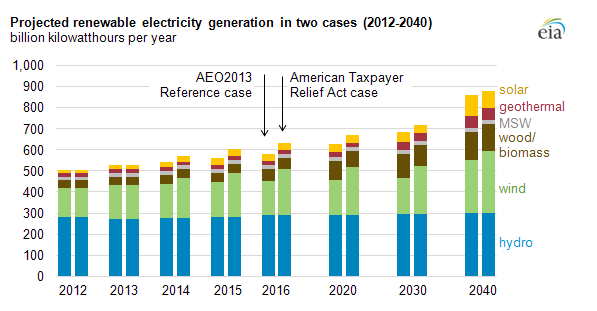Wind Industry Depends On Tax Credits More Than Other Renewables

A federal analysis of renewable energy tax credits indicates that wind power generation is significantly more dependent on federal tax breaks than all other forms of renewable energy. According to a study by the U.S. Energy Information Administration (EIA), the renewable energy Production Tax Credit (PTC), which Congress renewed in January, is likely to boost wind power capacity about 35 percent by 2016 while solar, geothermal, and other renewable energy sources would increase at about the same rate with or without the credit.
The PTC was the focus of intensive lobbying by the wind industry in the months before Congress extended it as part of the American Taxpayer Relief Act of 2012 (ATRA), which despite its name was passed on January 1, 2013. Wind power companies qualifying for the PTC receive 2.3 cents in tax credits for each kilowatt-hour their turbines produce. Despite pressure for a four-year extension, the PTC is now set to expire at the end of the year.
Wind gets most of the attention from the PTC, but aside from solar -- whose developers rely on a different tax credit program that reimburses construction costs -- the PTC applies to a whole range of renewable energy technologies including geothermal, hydroelectric and related technologies, several different kinds of biomass including landfill gas and municipal solid waste, tidal power, wave energy, and ocean thermal energy.
Comparing the PTC's effect on different renewable energy sources across the board is a bit of an exercise in comparing apples and oranges. Aside from the fact that solar doesn't qualify, the PTC treats the energy sources it does include differently. Wind, geothermal and closed-loop biomass facilities get the premium credit rate of 2.3 cents per kilowatt-hour, while other technologies get 1.1 cents.
Still, it's undeniable that in the EIA's reckoning, the PTC will have a disproportionately larger effect on wind development than on any of the other technologies it covers. Here's a graph from the EIA comparing their projections for renewable energy development. The "AEO2103" column for each year is the EIA's projection without the PTC; the "American Taxpayer Relief Act" column includes the PTC.

Compared to wind, which the PTC would boost in generating capacity by about 34 percent by 2016, the tax credit's effect on other technologies is almost negligible.
The wind industry will likely cast these figures as evidence that wind is the most effective PTC investment in terms of results per dollar. There's some validity to that argument. But the figures also point up a difference between wind and other forms of renewable energy: investment in wind is a bit of a gamble in ways that other forms of renewable energy are not.
If you put up a solar panel, that panel will generate power when the sun's out. Cloud cover will cut down output, but that's generally by a predictable amount on a predictable number of days per year. During the day, the sun's default condition is "on." With biomass and geothermal energy, if you build and maintain your equipment properly you'll generate power. Hydroelectric power is subject to some long-term uncertainty in these days of changed rainfall patterns, but on a day-to-day basis it's essentially rock solid.
Wind isn't like that. You can put up the most reliable turbine in the world and maintain it flawlessly, and if the wind slackens you don't produce power. If the wind gets too strong for your turbines, you don't produce power. Outside of a few very specific areas like the San Gorgonio Pass in Riverside County, wind is fickle and unpredictable.
Look at it this way: we used to have an entire global industry that was run completely on wind power, and that industry -- marine shipping -- abandoned wind power en masse without a second thought as soon as there was an alternative.
The Production Tax Credit doesn't make wind any more reliable. It just sweetens the payoff for those days when the wind does blow and the turbines generate power. It's no accident that the PTC might well boost wind power generating capacity far more than it would more predictable forms of renewable energy.
Without that tax credit -- which could amount to $132 a day for a 2.5 megawatt wind turbine even if it produces only at 10 percent of its rated capacity -- building many of those turbines just isn't worth the investment. The wind industry said as much last year, to Congress and to the rest of us.


